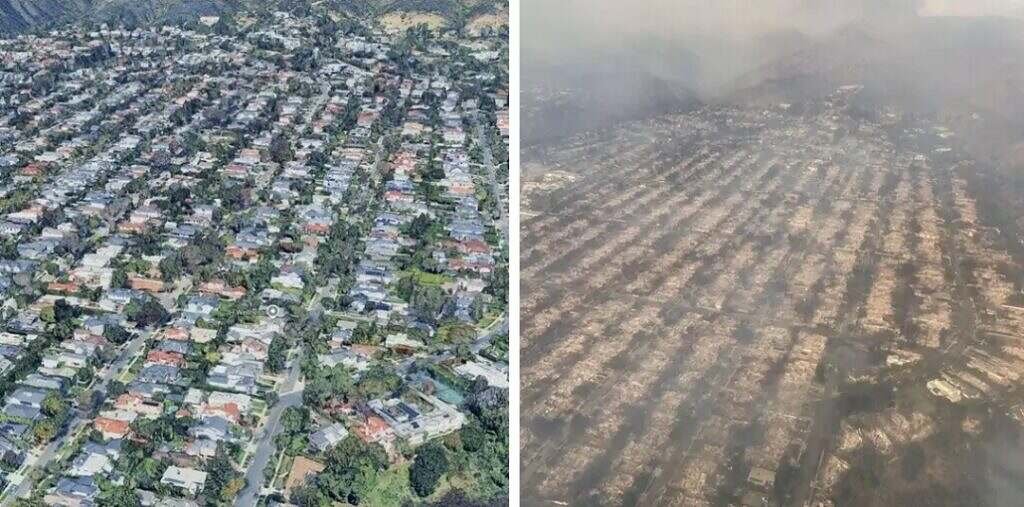
Introduction to Pacific Palisades
Pacific Palisades, a charming coastal neighborhood located on the western edge of Los Angeles, California, serves as an ideal merger of natural beauty and suburban tranquility. Nestled between the Santa Monica Mountains and the Pacific Ocean, this community is often celebrated for its scenic views, recreational opportunities, and proximity to the vibrant urban landscape of Los Angeles. The area is characterized by its lush parks, hiking trails, and stunning beaches, making it a desirable destination for both residents and visitors.
The origins of Pacific Palisades date back to the early 20th century when a visionary named Gladys D. Creighton sought to develop a community that would offer an idyllic coastal retreat. The area was initially intended to be a residential community that integrated nature with comfortable living, consisting of picturesque homes and scenic landscapes. Under Creighton’s direction, Pacific Palisades was conceptualized as a haven for artists, writers, and outdoor enthusiasts, which contributed to its allure as a preferred locality. This philosophy of blending the natural environment with residential life has continued to shape the neighborhood’s identity over the years.
Throughout its history, Pacific Palisades has attracted a diverse array of individuals seeking a respite from the hustle of city life. The neighborhood’s accessibility to the stunning coastline and its abundance of recreational activities have solidified its reputation as an outstanding coastal retreat, drawing both those looking to relocate and tourists eager for leisurely explorations. The development of this area over the decades illustrates a distinct transformation, reinforcing its significance within the larger Los Angeles metropolitan area while honoring its rich historical roots.
Historical Background: The Early Years
Pacific Palisades’ history begins well before its transformation into a residential community in the 1920s. The area’s natural beauty has long attracted visitors and settlers. Originally inhabited by the indigenous Tongva people, the region provided abundant resources, including fresh water and fertile land for agriculture. The stunning coastal views and favorable climate hinted at the area’s future appeal to newcomers.
The late 19th century marked a pivotal time in Pacific Palisades’ early development. In the 1890s, the Los Angeles area began to see an influx of settlers drawn by the promise of the burgeoning city. Notably, the Pacific Palisades area was largely untouched, characterized by scenic landscapes that captivated many. The first significant wave of development can be traced to the 1910s when individuals such as the visionary developer and architect, A.J. “Tony” Stimson, began to lay the foundation for what would become a flourishing community.
During this period, the Pacific Palisades was not simply an area designated for residential purposes; it served as a hub for various cultural and recreational activities. The allure of this coastal enclave attracted many affluent families seeking tranquility away from the hustle and bustle of nearby urban centers. Additionally, the Pacific Palisades’ development was marked by its unique “bungalow” style architecture, which further attracted families wanting a serene and aesthetically pleasing environment.
The establishment of the Pacific Palisades Association in 1921 was a significant milestone, solidifying the sense of community among the residents. Influential residents contributed not only to the growth of the neighborhood but also to its identity, shaping the future of this picturesque coastal area. Through careful planning and a focus on community, the early years of Pacific Palisades laid the groundwork for the vibrant neighborhood recognized today.
Architecture and Culture: The Aesthetic Evolution
Pacific Palisades, a scenic enclave located along the coastline of Los Angeles, has undergone significant transformations in its architectural landscape throughout the decades. Initially developed in the early 20th century, this area showcased a blend of Classic Revival and Craftsman architectural styles, reflecting the design preferences of that era. The Craftsman homes were particularly noteworthy for their emphasis on handcrafted woodwork and integration with nature, characteristic of the Arts and Crafts movement. Many of these early structures laid the foundation for the area’s unique aesthetic appeal.
As the mid-20th century approached, Pacific Palisades saw the rise of modernist architecture, emphasizing clean lines, open spaces, and a strong connection to the surrounding environment. The influence of prominent architects, such as Richard Neutra and Ray Kappe, resulted in several iconic homes that exemplified the mid-century modern design philosophy. These structures often featured expansive glass walls and flat planes, seamlessly blending indoor and outdoor living, an approach that resonated with the prevailing lifestyle of Southern California.
In more recent years, the architectural scene of Pacific Palisades has further evolved, embracing a mix of contemporary styles while paying homage to its historical roots. Designers have increasingly incorporated sustainable building practices, reflecting a broader cultural shift towards environmental consciousness. Innovative developments such as eco-friendly materials and energy-efficient designs have become prevalent, indicating a thoughtful response to modern challenges. Notable landmarks have also emerged as symbols of this evolution, demonstrating a harmonious blend of modern aesthetics with traditional influences, enriching the cultural tapestry of the area.
As we look at the diverse architectural styles and ongoing cultural dynamics within Pacific Palisades, it is evident that the area continues to evolve while retaining its distinctive charm and character.
Environmental Changes: The Natural Landscape
The natural landscape of Pacific Palisades has undergone considerable transformation throughout its history, influenced significantly by both environmental and human factors. Originally, this coastal region was characterized by its diverse ecosystems, which included coastal sage scrub, native grasslands, and chaparral. These habitats were rich in biodiversity, supporting various species of plants and animals native to Southern California. In this pristine environment, the area’s geographical features, such as the Santa Monica Mountains and proximity to the Pacific Ocean, contributed to its ecological wealth.
However, as urbanization began in the early 20th century, the Pacific Palisades area experienced dramatic alterations. Development projects led to the destruction of many natural habitats to accommodate residential and commercial spaces. Roads, homes, and other infrastructures replaced much of the native wildlife corridors, posing significant challenges for local flora and fauna. As a result, numerous species faced threats such as habitat loss, pollution, and climate change, all of which adversely affected their populations.
In response to these challenges, various preservation efforts have emerged aimed at protecting the remaining natural landscapes. Local organizations, community groups, and government entities have collaborated to restore areas that had previously been disrupted. Initiatives have focused on reintroducing native plants, controlling invasive species, and educating residents about the importance of biodiversity. While urban encroachment continues to pose threats, these concerted efforts have led to some successes in reclaiming and revitalizing the natural environment of Pacific Palisades.
Overall, the transformation of the natural landscape in Pacific Palisades illustrates the delicate balance between development and conservation. Continued attention to sustainable practices and environmental management is essential in preserving what remains of this unique ecosystem while accommodating the needs of modern life.
Economic Development: Growth and Challenges
The economic transformation of Pacific Palisades has been shaped by a dynamic interplay of residential and commercial real estate developments alongside significant economic trends. Initially established as a modest coastal community, the area has experienced substantial residential growth, driven in large part by its natural beauty and proximity to urban centers such as Los Angeles. This residential boom has attracted a diverse demographic, from wealthy individuals seeking second homes to families desiring a tranquil living environment. Consequently, property values have surged, amplifying the region’s appeal as an affluent enclave.
In addition to residential expansion, commercial real estate has flourished, with an increase in boutique shopping, dining establishments, and essential services aimed at residents and visitors alike. This growth has, in turn, stimulated the local economy, creating jobs and enhancing the overall quality of life. The rise in commercial activity has also contributed to a vibrant community atmosphere, making Pacific Palisades a desirable location for both businesses and consumers. As the economic landscape continues to evolve, urban planning initiatives have emerged to facilitate sustainable growth while addressing the community’s ever-changing needs.
However, this economic progress has not come without challenges. One of the primary issues facing Pacific Palisades is the sustainability of its infrastructure. Rapid development has put a strain on local roads, public services, and resources, prompting concerns among residents about the long-term viability of these infrastructures. Furthermore, ongoing disputes over land use and zoning regulations have led to tensions within the community regarding growth management. Balancing the desire for economic development with the necessity of preserving the area’s unique character remains a key challenge for Pacific Palisades as it navigates the complexities of its ongoing transformation.
Community and Demographics: Shifting Populations
The demographic landscape of Pacific Palisades has undergone significant transformations over the years, reflecting broader trends in urban migration and community identity. Historically, this affluent coastal neighborhood was primarily inhabited by a homogeneous population; however, recent decades have seen a notable increase in diversity. This shift can be attributed to various factors, including the allure of Pacific Palisades’ stunning natural scenery, its proximity to major Los Angeles employment hubs, and the overall appeal of suburban living within a vibrant metropolis.
As new residents have relocated to the area, they have brought with them diverse cultural backgrounds, lifestyles, and perspectives that enrich the community’s social fabric. This demographic evolution has naturally influenced local events and community interactions, fostering a more inclusive atmosphere. Neighborhood gatherings and cultural celebrations now reflect a wider array of traditions and languages, thereby enhancing community engagement and cohesion.
Furthermore, the changing demographics have impacted local businesses and services, with an increased demand for a variety of culinary offerings, retail options, and recreational activities that cater to a broader audience. As a result, entrepreneurs are adapting their ventures to serve this evolving clientele, contributing to the dynamic economic landscape of the Pacific Palisades. The introduction of various cultural festivals and events illustrates residents’ collective efforts to celebrate their diverse backgrounds while fostering a sense of belonging.
In essence, the transformation of the community and demographics in Pacific Palisades is not merely a statistical shift; it represents a living, breathing change that has ramifications for local culture and social interactions. These dynamics serve to continually shape the identity of Pacific Palisades as a vibrant and inclusive neighborhood, illustrating the significance of adaptability in sustaining community resilience.
Recreation and Lifestyle: Past vs Present
The recreational landscape of Pacific Palisades has undergone significant transformations throughout its history, reflecting changes in lifestyle, community engagement, and leisure activities. In the early 20th century, the area was characterized by limited recreational options, primarily focusing on outdoor pursuits. Hiking trails and beach activities dominated the recreational offerings, as residents and visitors alike took advantage of the natural beauty surrounding the coastline. The sense of community was cultivated through simple, communal gatherings along the beach, fostering connections among families and friends.
Fast forward to the present, Pacific Palisades boasts a diverse array of recreational facilities and lifestyle options that cater to an increasingly active and varied populace. The development of parks, sports facilities, and community centers has provided residents with the means to engage in a broader spectrum of activities ranging from organized sports to cultural events. The establishment of the Palisades Recreation Center exemplifies this shift, offering extensive programming that encourages social interaction and community involvement. Modern conveniences such as yoga studios, fitness centers, and bike paths have also become prominent, reflecting the growing emphasis on health and wellness.
Moreover, lifestyle choices have transformed, with an increasing inclination towards pursuing sustainable and eco-friendly recreational practices. This focus is evident in the rise of wellness retreats, organic farmer’s markets, and outdoor programs highlighting environmental stewardship. The juxtaposition of traditional recreational activities with contemporary lifestyle trends reveals a community that respects its historical roots while embracing the complexities of modern living.
Ultimately, the evolution of recreation in Pacific Palisades underscores not only the changes in leisure activities over the years but also the broader societal shifts influencing how residents and visitors engage in their community. As Pacific Palisades continues to develop, its unique blend of historical and modern pursuits fosters a dynamic environment for all.
Impact of Technology and Modernization
The transformation of Pacific Palisades over the years can significantly be attributed to advancements in technology and modernization. These changes have profoundly influenced various facets of daily life, making the area more accessible and connected. One of the most notable transformations has been in communication. The introduction of high-speed internet and mobile connectivity has revolutionized how residents and businesses interact. Enhanced communication tools have enabled the local community to foster relationships, promote businesses, and engage in social activism, effectively bridging the gap between individuals and organizations.
Transportation improvements have also played a vital role in reshaping Pacific Palisades. The development of new roadways, public transportation options, and ride-sharing services has made commuting significantly more efficient. Residents can now navigate to neighboring cities with ease, reducing travel time and promoting a greater sense of community. However, these advancements have not come without challenges; increased traffic congestion and environmental concerns have emerged as pressing issues. While modernization facilitates greater mobility, it also necessitates careful planning and consideration of its long-term effects on the infrastructure and landscape.
Furthermore, the local economy has seen noteworthy impacts due to technological progress. Businesses have embraced digital marketing and e-commerce platforms to reach wider audiences, thereby boosting sales and enhancing customer engagement. Small enterprises, in particular, benefit from the ability to operate online, allowing them to compete with larger corporations. Nevertheless, the rapid shift toward technology-driven practices can create obstacles for traditional businesses that may struggle to adapt to changing consumer preferences and market dynamics.
In conclusion, Pacific Palisades has experienced a notable transformation due to technological advancements and modernization. While these developments have improved communication, transportation, and commerce, they have also introduced complexities that require thoughtful management. Balancing the benefits and potential downsides of these changes will be essential for fostering a sustainable community.
Conclusion: The Future of Pacific Palisades
As we reflect on the historical evolution of Pacific Palisades, it is evident that this coastal community has experienced significant transformation over the years. From its early days as a picturesque seaside retreat to its current status as a sought-after residential enclave, the changes are not only reflective of shifting demographics but also of evolving urban development trends. The unique blend of natural beauty and community spirit continues to define Pacific Palisades, marking its journey through history.
In recent years, there has been a notable increase in interest from developers, with projects aimed at enhancing local amenities and housing availability. This has sparked conversations about the balance between preservation and development, as residents express varying opinions on the changes being proposed. The introduction of sustainable initiatives alongside modern designs might cater to the increasing demand for eco-friendly living spaces, making Pacific Palisades not only desirable but also a role model in sustainability.
Looking ahead, the potential developments in Pacific Palisades must be approached with caution and an eye toward the community’s rich cultural heritage. As new businesses and residential options emerge, it is crucial that they align with the current lifestyle and values of the community. Moreover, community engagement will play a vital role in shaping the future. By encouraging open discussions among residents, local leaders can ensure that the evolution of Pacific Palisades reflects the desires of its citizens.
Overall, Pacific Palisades stands at the juncture of opportunity and change, with a bright future on the horizon. Preservation of its unique character, combined with thoughtful modernization, will help to construct a thriving community that honors its past while preparing for the future. As we consider the next chapter for this vibrant locale, it is clear that the essence of Pacific Palisades will continue to evolve while remaining rooted in its historical legacy.






